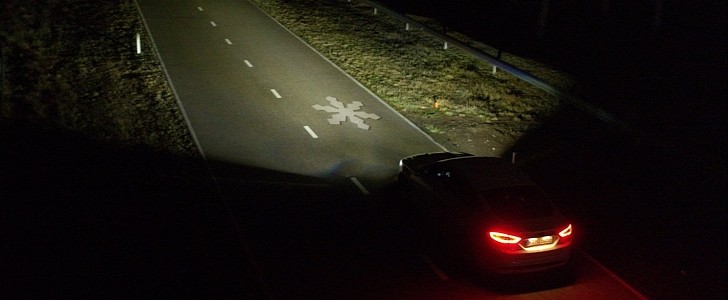Ford Europe is testing new headlight technology that can replace the head-up display by projecting useful information on the road ahead, in the driver’s sight. This helps keep the driver’s eyes on the road, enhancing safety.
I must confess, I hate head-up displays. Although many swear by this tech, I find myself distracted by it. I only need to see specific information once in a while. For the rest of the time, the flickering image just annoys me. That’s why the new headlight technology Ford developed could be a lifesaver. Instead of having a virtual screen in front of your eyes, potentially affecting the view outside, Ford thinks projecting the same information on the road ahead is much safer.
And indeed it is. The driver would not have to adjust his vision to different distances, as the images would be more naturally represented on the road ahead. A teaser video demonstrates the technology projecting information like speed limits, navigation indications, or road signs in front of the driver. They would not even need to take their eyes off the road to see it, which is precisely the point.
There are no limits to what this tech can do, from projecting driving indications to helping with parking maneuvers in tight spots. Imagine the headlights giving you live indications when parking or even helping decide if a parking spot is wide enough to fit the car. Ford also mentions “entertaining applications,” which could be an entirely new world.
Although this sounds incredibly useful, it might not work for everyone, and Ford might have a hard time getting the necessary homologation. It could work on an empty road, but what about highway traffic with many similar vehicles in the adjacent lanes, all projecting stuff on the road? This sounds like a potential visual cacophony. Not to mention how difficult it would be to spot the projected images in a bright environment in city traffic.
Ford previously showed another headlight tech that can link the adaptive headlights to the navigation system to better predict how to illuminate the road. It’s clear that the Dearborn company is genuinely preoccupied with lighting tech. Hopefully, something good will come out of these struggles.
And indeed it is. The driver would not have to adjust his vision to different distances, as the images would be more naturally represented on the road ahead. A teaser video demonstrates the technology projecting information like speed limits, navigation indications, or road signs in front of the driver. They would not even need to take their eyes off the road to see it, which is precisely the point.
There are no limits to what this tech can do, from projecting driving indications to helping with parking maneuvers in tight spots. Imagine the headlights giving you live indications when parking or even helping decide if a parking spot is wide enough to fit the car. Ford also mentions “entertaining applications,” which could be an entirely new world.
Although this sounds incredibly useful, it might not work for everyone, and Ford might have a hard time getting the necessary homologation. It could work on an empty road, but what about highway traffic with many similar vehicles in the adjacent lanes, all projecting stuff on the road? This sounds like a potential visual cacophony. Not to mention how difficult it would be to spot the projected images in a bright environment in city traffic.
Ford previously showed another headlight tech that can link the adaptive headlights to the navigation system to better predict how to illuminate the road. It’s clear that the Dearborn company is genuinely preoccupied with lighting tech. Hopefully, something good will come out of these struggles.







